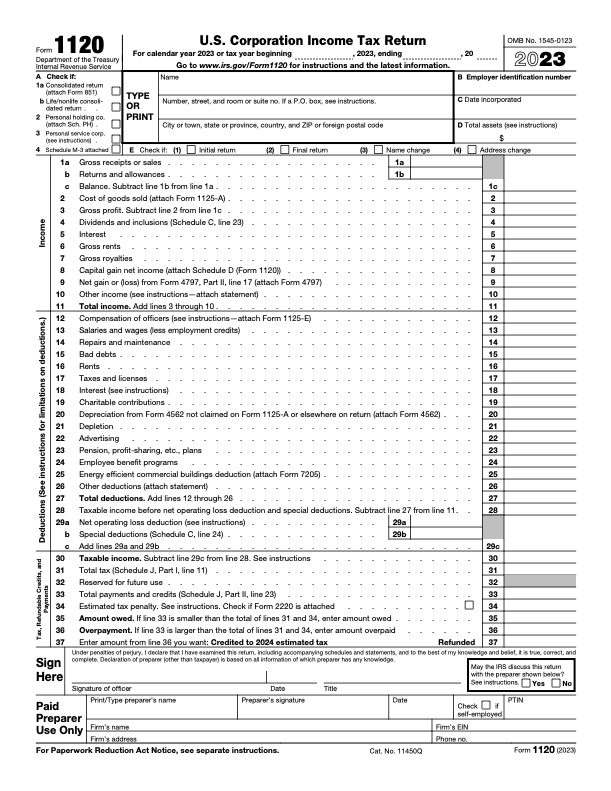Table of contents
From car expenses to business lunches, there are many things to consider when it comes to tax time. In fact, Statista data shows that taxes are one of the top concerns for small-business owners in 2024. Filing taxes can be a complicated process, but whether you are filing forms yourself directly through the IRS, using a tax software, or working with a tax professional, having a better understanding of the forms your business needs to file can ease the stress of tax time.
Form 1120: What it is and how to file
Form 1120 is a U.S. Corporation Income Tax Return form. It is used to report income, gains, losses, deductions, and credits, and to determine the income tax liability of a corporation. This is the tax form C corporations and LLCs use to file their income taxes. (If a business entity with two or more members is formed as an LLC, it is generally treated as a partnership.)
Unless exempt, all domestic corporations must file an income tax return, whether or not they have taxable income. Unless you are a domestic corporation that is required (or elects) to file a special return, you must file Form 1120.
You can file Form 1120 online or by mail. Typically, a company must file its income tax return by the 15th day of the 4th month after the end of its tax year. There are, however, exceptions to this, such as weekends or holidays, so be sure to refer to the latest IRS instructions form for more details.
How to file Form 1120 online
You can fill out Form 1120 online for free with IRS Free File, or with a tax software if you feel comfortable filling out and filing this form yourself. Otherwise, you can hire a professional tax preparer to file Form 1120 online. The IRS also provides more detailed instructions around recent legislation and developments related to Form 1120.

What are some filing requirements for businesses?
Form 1120 is a six-page document with several sections. Let’s break down this form and look at how to complete each section. Remember, if you have questions about Form 1120, please consult a professional.Corporation details
At the top of the first page, you are asked to provide details of your corporation, including its name, address, incorporation date, employer identification number, and total assets.
Income and deductions
On the first page you are required to populate your income and deductions. Start by detailing all relevant income streams, such as profit, interest, and dividends. Then list your deductions, including salaries and wages, benefits programs, and charitable contributions.
Schedule C: Dividends, inclusions, and special deductions
Schedule C is where you will need to report any dividends received from U.S. and foreign entities. If your corporation doesn’t receive dividends, you can skip this section.
Schedule J: Tax computation and payment
Schedule J is where you will need to report the total taxes your corporation owes for the tax year. It considers any potential deductions to your tax liability, such as business tax credits, overpayment of taxes from the previous year, and any estimated tax payments made during the current year.
Schedule K: Other information
Schedule K is for any other details relevant to your tax return, including information about the ownership structure of your corporation, its involvement in foreign activities, and any tax-exempt income. You only need to populate the lines that are relevant to your company.
Line 13 asks whether your corporation’s total income and assets are more than $250,000. If they are, you don’t need to complete Schedule L.
Schedule L: Balance sheets per books assets
Schedule L requires you to transfer the details from your company’s balance sheets, including assets, liabilities, and shareholder equity. The IRS compares this information against other sections of Form 1120 to ensure that what you have reported is consistent.
Schedule M-1: Reconciliation of income
Schedule M-1 is where you reconcile the income reported on your financial statements with your taxable income. It includes reporting items such as income and expenses that are recorded for financial purposes but not for tax purposes.
Schedule M-2: Analysis of unappropriated retained earnings per books
Schedule M-2 refers to retained earnings that haven’t been allocated for any specific use in your company’s financial records. In other words, the amount of money available to your corporation that hasn’t been earmarked for any particular purpose, such as dividends or reserve funds.
About the Form 1120 series
There are several special forms related to Form 1120 that may be needed for your business, depending on its legal structure. Below are a few that may be relevant:
- 1120-C: U.S. income tax return form used by cooperatives
- 1120-H: U.S. income tax return form used by condominium management, residential real estate management, and more
- 1120-L: U.S. income tax return form used by life insurance companies
- 1120-S: U.S. income tax return form used by S corporations
There are several types of organizations that the IRS considers to be tax-exempt. These include charitable organizations, social welfare organizations, labor organizations, and social clubs. These entities are typically required to file annual informational returns, such as Form 990 or Form 990-EZ, to maintain their tax-exempt status and to provide transparency about their financial activities.
![]()











